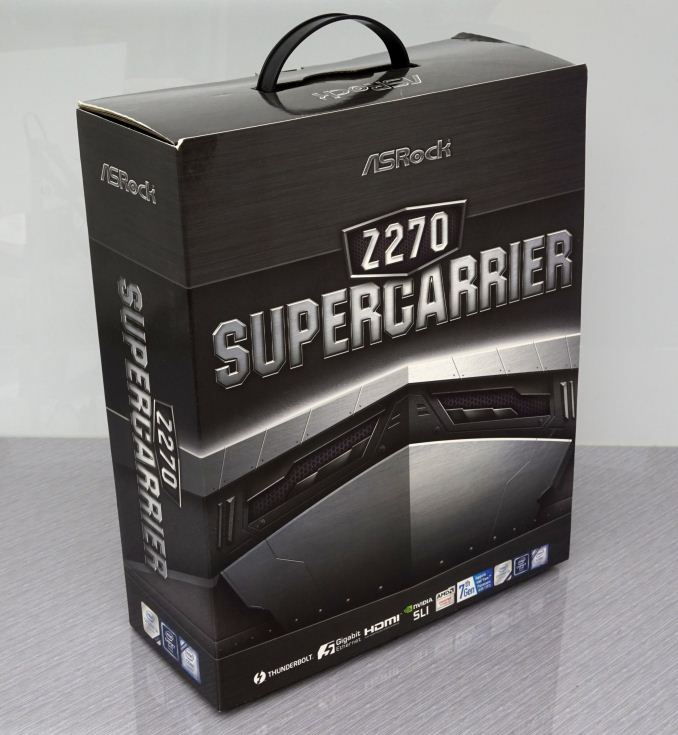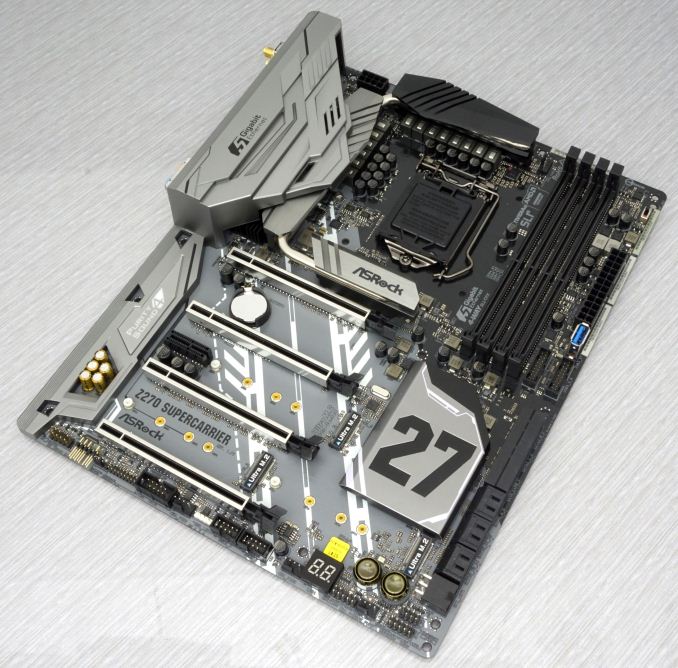The ASRock Z270 Supercarrier Motherboard Review: 4-way SLI and 5 Gigabit Ethernet on Kaby Lake
by E. Fylladitakis on September 29, 2017 9:00 AM EST- Posted in
- Motherboards
- ASRock
- SLI
- Aquantia
- Z270

Ever since Intel released the Z270 chipset earlier this year, we reviewed several motherboards based on it, ranging from the low-cost Mini ITX ECS Z270H4-I Durathon 2 to the advanced gaming motherboards from Asus and GIGABYTE. As literally dozens of Z270-based motherboards were released, we could not possibly review them all and we centered our choices on products that we believed to be of interest to the largest portion of our readers. However, someone could argue that even though the top-tier market is relatively small, it also consists of the most knowledgeable and demanding users, who cannot fulfill their wants and needs with a mainstream motherboard.
In this review, we are having a look at the ASRock Z270 Supercarrier, a top-tier motherboard designed for professional designers and elitist gamers. Despite its typical ATX dimensions, the Z270 Supercarrier is loaded to the hilt, with a tremendous number of connectors and several features that cannot be found on mainstream motherboards. While the price tag will drive every casual/mainstream user away instantly, the Z270 Supercarrier is one of the few choices with a LGA1151 CPU socket available for professional designers and gamers who are not satisfied with one or two GPUs.
The ASRock Z270 Supercarrier Overview
A simple glance at the list of this motherboard’s features is likely to leave most people in awe. If we were to single out the highlights of the Z270 Supercarrier, these would be the 14-phase CPU power circuitry, the four PCIe ×8 slots for full-size graphics cards and the AQUANTIA 5 Gbps network controller, all of which are features that cannot be found on mainstream motherboards. The number of supported storage devices is immense, with three PCIe ×4 M.2 slots, six SATA connectors and two SATA Express connectors. Each SATA connector may also be used as two standard SATA ports, bringing the maximum number of regular SATA devices up to 10 if no SATA Express devices are installed. There are no U.2 connectors and this is one of the very few features that the Z270 Supercarrier is lacking. This problem can be easily tackled with the use of proper M.2 to U.2 adapters.
The ASRock Z270 Supercarrier also has very interesting controllers installed. The “Purity Sound 4” onboard audio has a popular ALC1220 audio controller supplied by Realtek at its heart, supported by a Texas Instruments NE5532 headset amplifier and other hardware. It has not one, not two, but three different LAN controllers. The first is the Aquantia AQC108 5 Gbps controller, which is one of the highlights of this motherboard. Intel supplies the other two Gigabit controllers (I219V and I211AT), as well as the wireless LAN module (AC3160). We also found several controllers from ASMedia on the Z270 Supercarrier for additional USB, SATA, and Thunderbolt ports.
In summary, the ASRock Z270 Supercarrier is a motherboard primarily designed to entice professional designers, users who usually are seeking to build 3-way and 4-way SLI systems with a lot of storage devices. That is a very limited segment of the market and ASRock’s engineers are clearly trying to expand it by adding features that would also tempt gamers and overclockers with very large budgets. Even in its default configuration, the ASRock Z270 Supercarrier manages to outperform every other Z270-based motherboard that we have tested to this date, while it also displayed very promising overclocking capabilities during our testing. At this point we should mention that the higher overall performance does not come from any magic tricks but, as we found out during our testing, by ASRock’s engineers “cheating” and setting the CPU’s Turbo multiplier at 45 by default, allowing a 7700K processor to reach 4.5 GHz without tweaking any BIOS settings or other options.
Quick Board Feature Comparison
| Motherboard Comparison | ||
| ASRock Z270 Supercarrier | ||
| Socket | LGA1151 | LGA1151 |
| MSRP at Review | $349 | $140 |
| DRAM | 4 x DDR4 | 4 x DDR4 |
| PCIe Layout | ×8/×8/×8/×8 | x8/x8 |
| BIOS Version Tested | 1.11 | 2.00 |
| MCT Enabled Automatically? | No | Yes |
| USB 3.1 (10 Gbps) | Intel JHL6540 | None |
| M.2 Slots | 3 x PCIe 3.0 x4 | 2 x PCIe 3.0 x4 |
| U.2 Ports | No | No |
| Network Controller | 1× AQC218 / 1 x Intel I219-V / 1 x Intel I211-AT | 1 x Intel I219-V |
| Audio Controller | Realtek ALC1220 | Realtek ALC892 |
| HDMI 2.0 | No | No |
Other AnandTech Reviews for Intel’s 7th Generation CPUs and 200-Series Motherboards
($110) The ECS Z270H4-I Durathon 2 Review
($140) The ASRock Z270 Killer SLI Review
($140) The MSI Z270 SLI PLUS Review
($159) The ASRock Z270 Gaming-ITX/AC Review
($170) The Asus Prime Z270-A
($170) The GIGABYTE Z270X-Ultra Gaming
The Intel Core i7-7700K (91W) Review - CPU Review
The Intel Core i5-7600K (91W) Review - CPU Review
The Intel Core i3-7350K (60W) Review - CPU Review
Our Latest Best CPU Recommendations
In comparison to the older Z170 boards, the new Z270 board on the base specifications are hardly any different. The Z270 ones have four extra PCIe lanes configurable on the chipset, potentially new audio and new networking controllers, and Intel Optane Technology Support. Although four extra PCIe lanes do sound like a huge difference, it is an important upgrade for the implementation of native M.2 slots (on Z170-based motherboards, this usually meant disabling some other device/port on the motherboard). Also, note that Intel Optane drives should still function on other chipsets as drives; the Z270 only allows them to enable their “smart caching” technology.
The Intel Optane Memory (SSD) Preview: 32GB of Kaby Lake Caching
Individual motherboard manufacturers will be sprinkling on new features onto their Z270 products to aid the transition and provide other tangible benefits over the old platform. To read specifically about the Z170 chip/platform and the specifications therein, our deep dive into what it is can be found at this link.
A Small Note on USB Naming
One thing that we should note is that the advent of the Z270 chipset brought a change on the naming of the USB ports. What we knew as USB 3.0 ports are now being dubbed as “USB 3.1 Gen 1” and the 10Gbps ports are now called “USB 3.1 Gen 2”. We first encountered this change while reviewing the MSI Z270 SLI Plus a few months ago but it seems that most of the manufacturers are following suit, rewriting their websites and reprinting their manuals. Users need to be extra careful when very high bandwidth connectors are essential.












50 Comments
View All Comments
edzieba - Saturday, September 30, 2017 - link
A 'headphone amplifier' is just an op-amp used correctly in its linear region. Marketing departments may wish to tell you otherwise, but there is nothing magical about them.extide - Friday, September 29, 2017 - link
WHY are we still seeing boards with SATA Express... That just needs to die!Regular Reader - Sunday, October 1, 2017 - link
Same reason this motherboard still has PS/2 on it.Samus - Saturday, September 30, 2017 - link
Is triple\quad SLI still a think? I mean, at what point are 2x 1080Ti's or 2x Vega64's not good enough for any game at any reasonable resolution even across multiple monitors?Regular Reader - Sunday, October 1, 2017 - link
Apparently there are enough buyers still out there (for multiple motherboard vendors no less) that want the braggingest brag of a gaming rig out there, regardless of the paltry 5% performance increase 3 and 4 cards affords.Notmyusualid - Sunday, October 8, 2017 - link
Its not all about gaming....CrazyHawk - Friday, October 6, 2017 - link
There are other uses for 4-way GPUs other than gaming. An inexpensive deep-learning rig is one of them. 16 PCI 3 lanes still provide 15.8 GB/second total bandwidth. With the PEX 8747 chip (in a 2-GPU system), if a single card is exchanging data with the CPU, it gets the entire 15.8 GB/second bandwidth, and GPU to GPU transfers are at 15.8 GB/second without involving the CPU.On GoogLeNet, with a GTX 1070, time spent transferring data at x16 is about 3% of runtime. With AlexNet (same hardware), it is about 5.5% of runtime. That means that for 95% of the job, there is no data going over the PCI x16 links. The PEX 8747 can give full access to the 16 PCI lanes to each GPU during that 95% of the time. With 4 GPUs, each gets x8 lanes, so the transfer time doubles, but it is still just around 10% of runtime, and only 40% of the total bandwidth is used (this analysis ignores optimizations possible through pipelining the data transfer with the compute).
The GTX 1080Ti is about twice the speed as the GTX 1070, so with 4 1080Ti cards, you are using near 80% of the bandwidth, which starts to become a stretch. But if you can afford 4 1080Ti cards, you can probably afford an HEDT machine. For getting started with deep learning, this motherboard, an 8700K processor, and 4 used GTX 1070 or GTX 1060 GPUs (after the mining craze goes bust) would be a very inexpensive way to build a real AI supercomputer.
Does anyone have any rumors/ideas on when the z370 version of this board will come out? (or the ASUS z370-WS version of their board?)
Notmyusualid - Sunday, October 8, 2017 - link
@ CrazyHawkPeople have been telling me since 2007, that mining is going to go bust:
1 Bitcoin equals 4469.43 US Dollar
Mining has changed, but alive & kicking!
oranos - Monday, October 2, 2017 - link
nobody knows how to push the irrelevant innovation of hardware quite like the ethernet industrywagletops - Tuesday, October 3, 2017 - link
save all these reviews for when the 370 comes out :)http://www.appcheatsonline.com/roblox-robux/